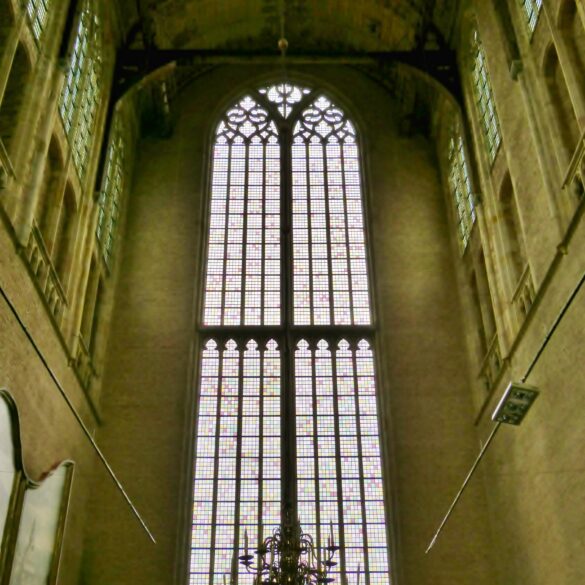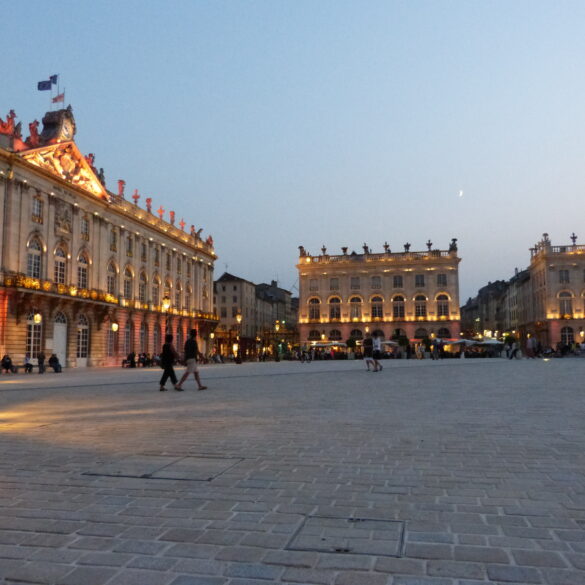While we were in Rothenburg ob der Tauber the weekend before Christmas, we made a side trip to the town of Dinkelsbühl, which is about 35 minutes south on what’s called The Romantic Road.
The Romantic Road (Romantische Straße in German) is about 220 miles long and has lots of “typical” German towns and attractions for tourists to visit. The idea of the Romantic Road was developed in the 1950s to promote tourism and it is actually managed out of Dinkelsbühl today. The road used to be a trade route in olden days. There is a tour bus that runs along the route, but it’s better if you can do it by car. You can pick up maps and information about the road at a tourist information center in any of the towns along the way and sightsee at your own pace.
By the way, that letter ß that you see in the word Straße above is called an eszett and is a double s. So, in English you would write the word as strasse, which means street or road.
Dinkelsbühl is a completely intact medieval town because it was not damaged at all during World War II.
We got lucky and got the last parking spot in a tiny lot just outside the old city walls. This was the view from the parking lot.
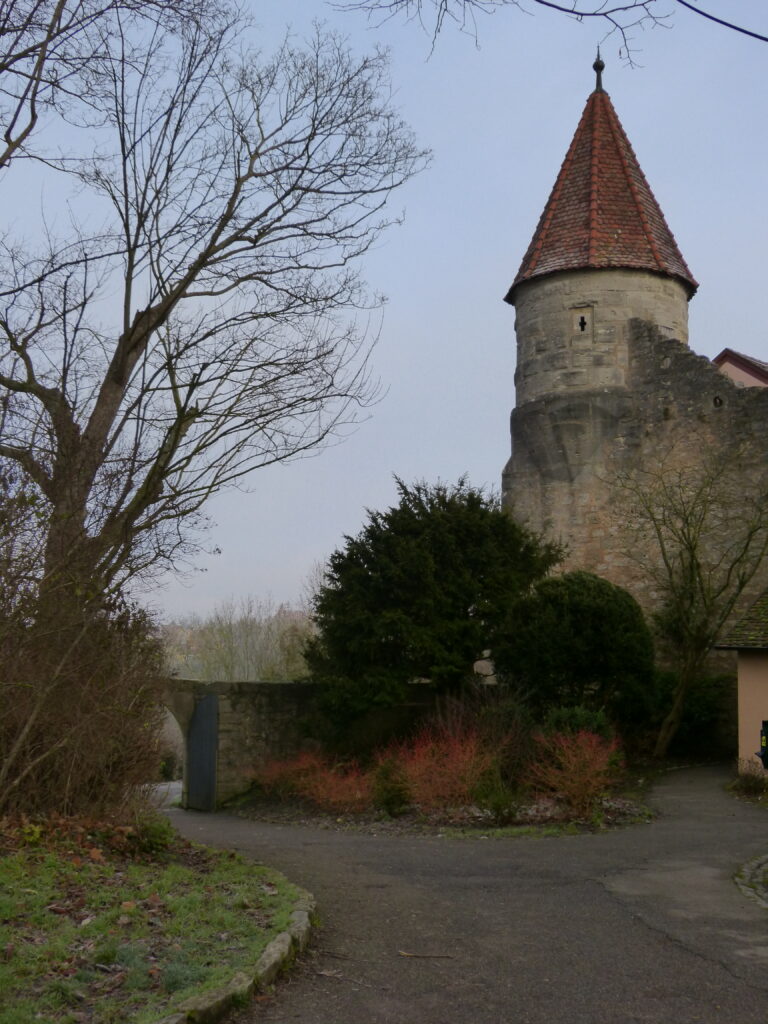
The rounded tower is called the Dreigangsturm.
Upon walking out of the parking lot, we saw this tower.
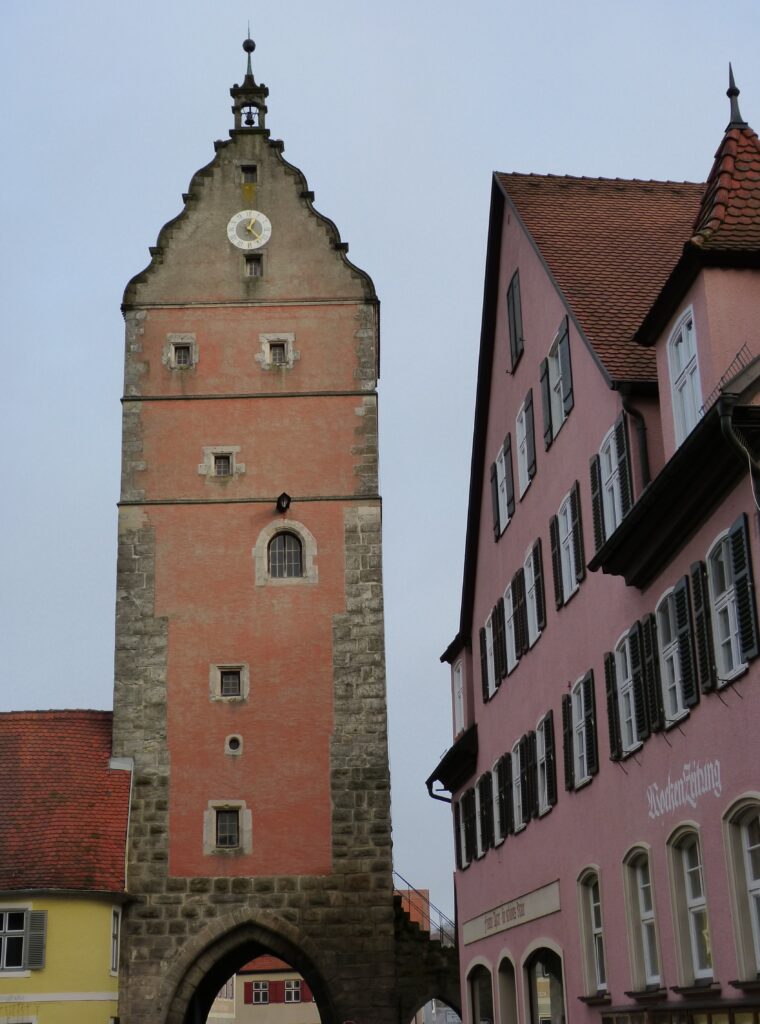
It’s called the Wörnitz Gate and is the oldest of Dinkelsbühl’s four city gates.
The Tourist Information (TI) office was in the town hall next to the parking lot, so we stopped in there and picked up a map with a walking tour written in English.
We stopped into the St. Paul church and saw an interesting manger scene set up.
This angel sort of looks like it’s being strangled, doesn’t it?
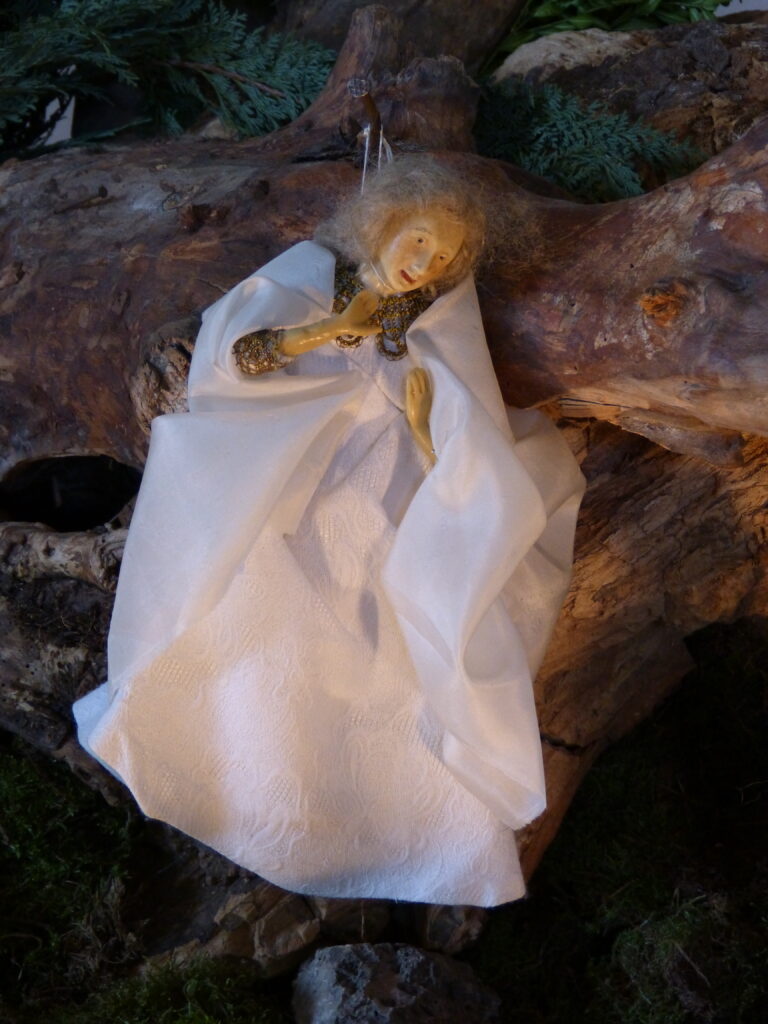
And Sean said this figure made it look like there were zombies in Bethlehem.
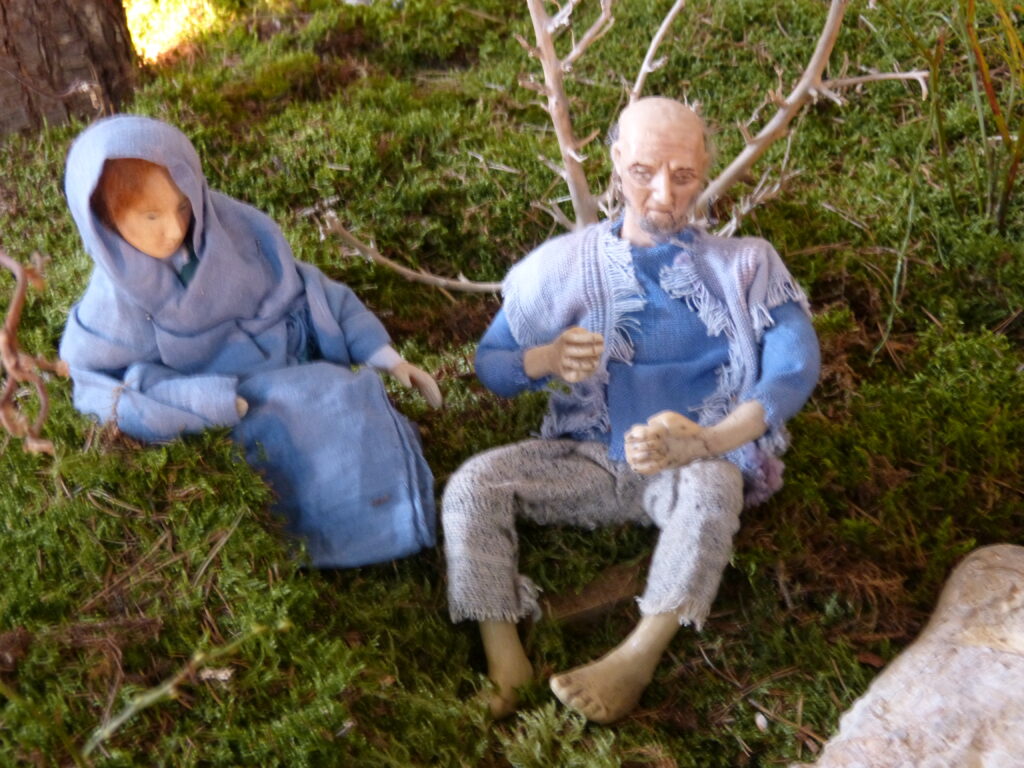
Here is a view of the St. George church on the right, and on the left are buildings on what’s called the Wine Market.
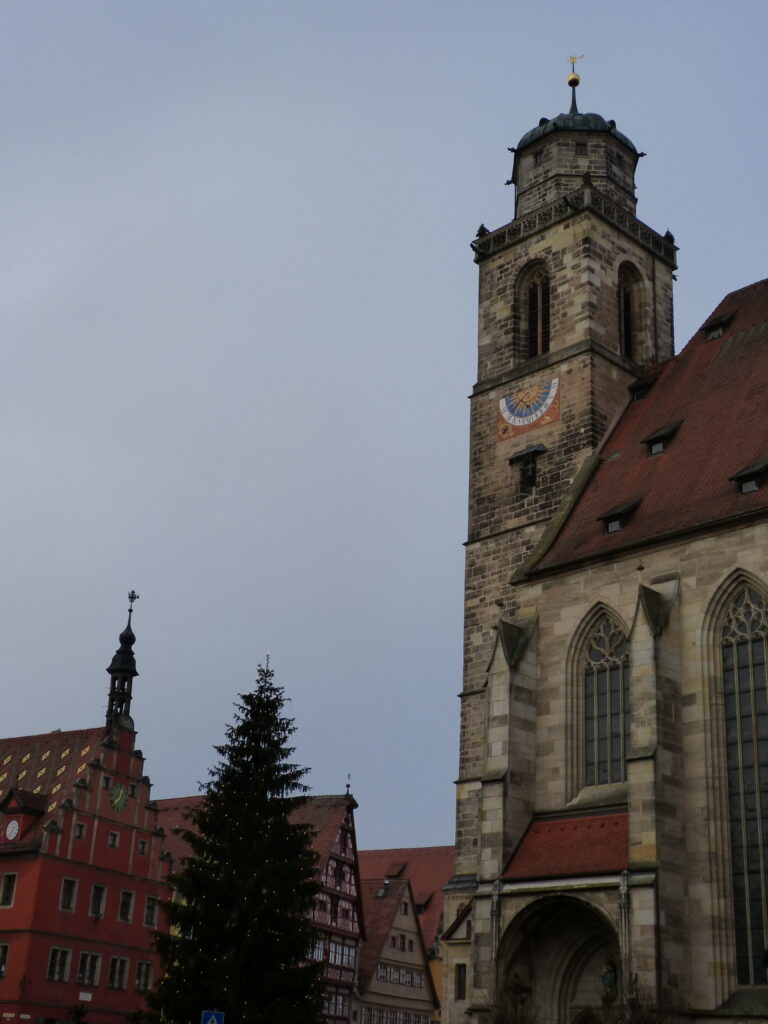
St. George church is a gothic church that was built in the 15th century. You can climb to the top of its tower but I had had enough tower climbing in Rothenburg the previous day.
The house in this next photo, called the Gustav-Adolf-Haus, in one on the Wine Market that you caught a glimpse of in the previous photo.
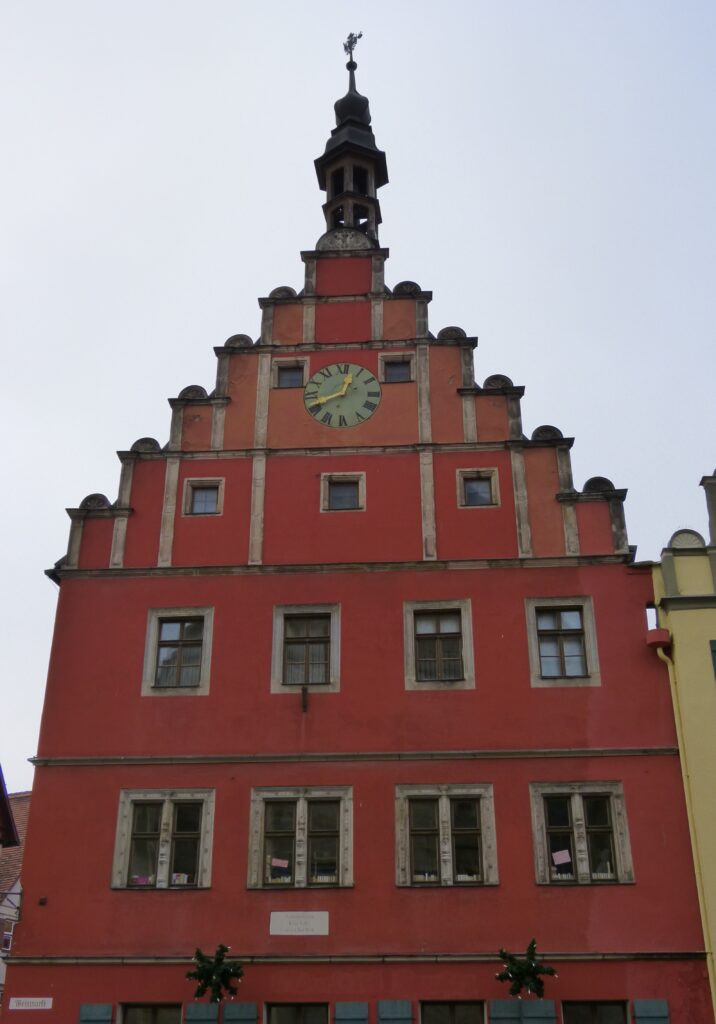
It used to be a weighing house where, as you might guess, goods were weighed. Notice the cute little dome perched on top of the building.
This building is next to the Gustav-Adolf-Haus and is called the Deutsches Haus.
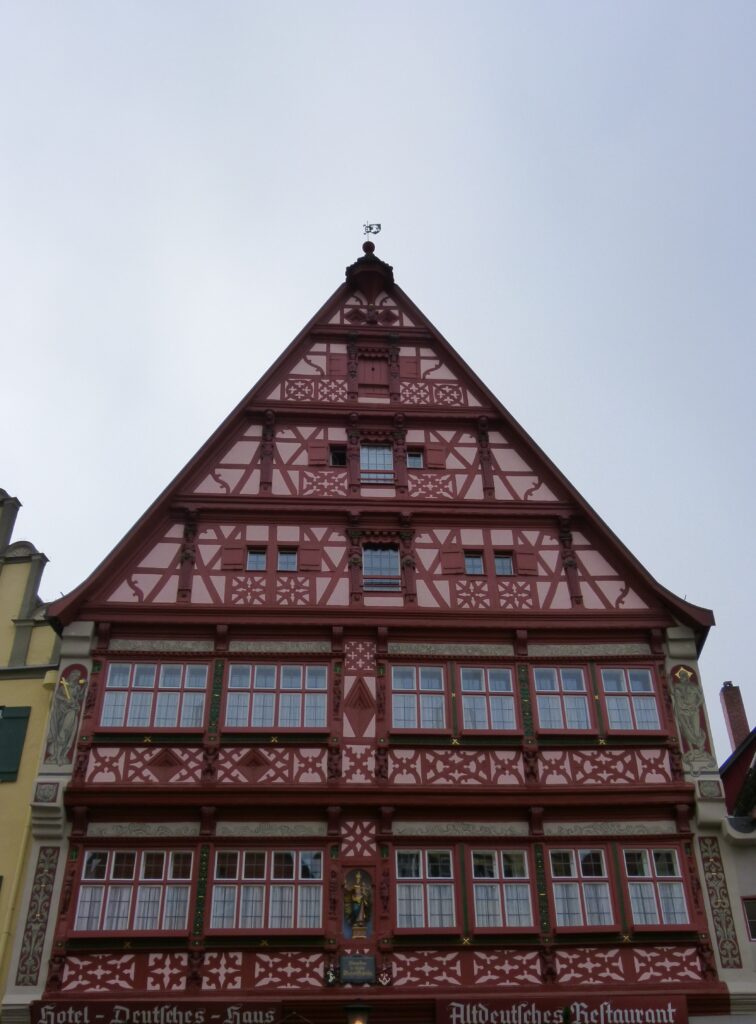
It’s a very ornately-decorated house with statues on the Renaissance façade. It now houses a hotel and restaurant.
Next to the Deutsches Haus is a building called the Schranne.
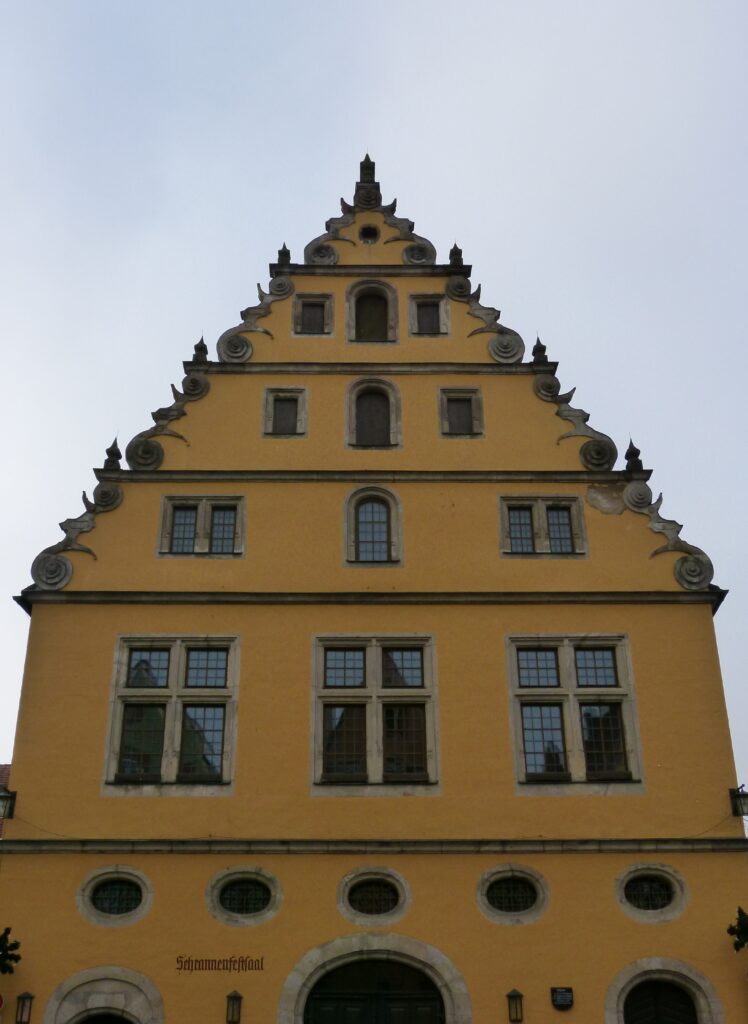
It used to be a corn storehouse and now contains seminar and conference rooms.
All 3 of the buildings shown above date from about the year 1600.
Just down the street from the Schranne building was the Dinkelsbühl Christmas market.
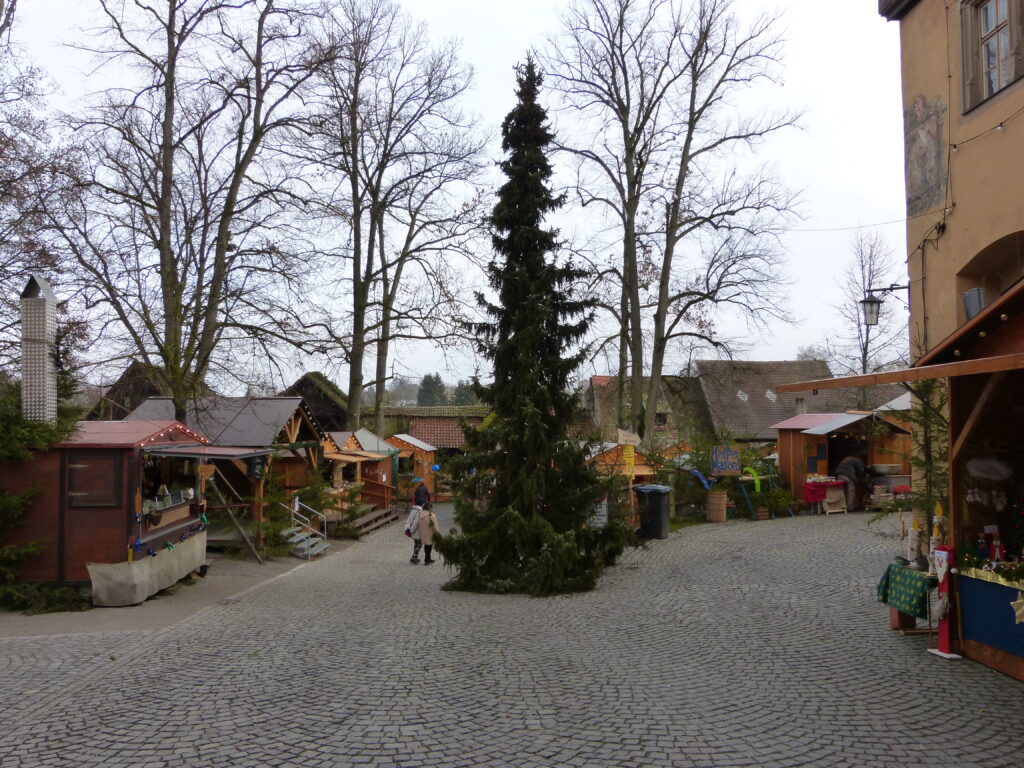
We saw a Glühwein (mulled wine) stand with what looked like some nice mugs, so we decided to share a drink and keep the mug. If you read my Christmas market blog, you’ll know that when you get a drink like that at a festival in Germany, you generally pay what’s called a Pfand or a deposit for the cup or mug. When you return your mug, you get your deposit back. If you’d like to keep the mug, though, you just forfeit the deposit, which is usually around 2 Euro.
When we got the Glühwein, Sean asked the guy for one of the white mugs. The guy then asked us – in perfect English, of course – whether we planned to keep the mug. When we confirmed that we did, he gestured to a pile of gift bags with clean mugs in them and said he’d give us one of those when we were done with the drink. I suppose we could have just paid him the deposit for a mug and skipped the Glühwein part but who am I kidding? It was actually one of the better-tasting Glühweins that we’ve had. I have never seen the mug-in-a-gift-bag thing at any of the other numerous Christmas markets we’ve visited.
When we were done with the drink, the guy asked if we wanted the same white mug and we said we did. He said “Well let me show you our new mug” and then busted this out.
(Christ Mark)
This is the first mug I’ve ever seen with a QR code on it – how cool is that? When you scan it, the town’s website comes up with music and a video. Of course we quickly ditched the idea of the white mug and took this one instead to add to our collection.
This sign was at this same Glühwein stand and is also something I’ve never seen before at a Christmas market.
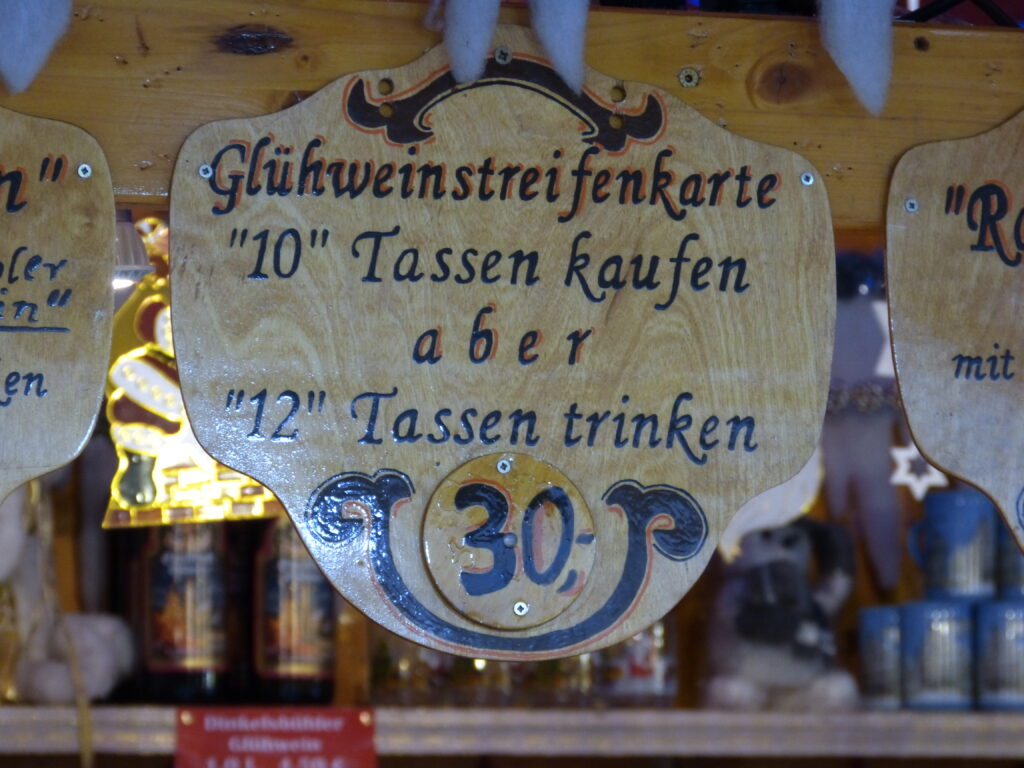
It basically means you pay 30 Euro for 10 Glühweins but you get 12 drinks instead! Such a deal. If we didn’t have to drive back to Rothenburg we might have taken advantage of it.
Up until this point in our little self-guided walking tour we saw a handful of other tourists, but nothing even close to what we’d seen in Rothenburg. From this point on, though, we didn’t run into a single other tourist until we got back to the St. George church. It’s a shame because I think I’d recommend visiting Dinkelsbühl over Rothenburg if I had to pick between them. One drawback for a lot of tourists, though, is that Dinkelsbühl does not have a train station.
Our walking tour took us around what’s called the Rothenburg pond.
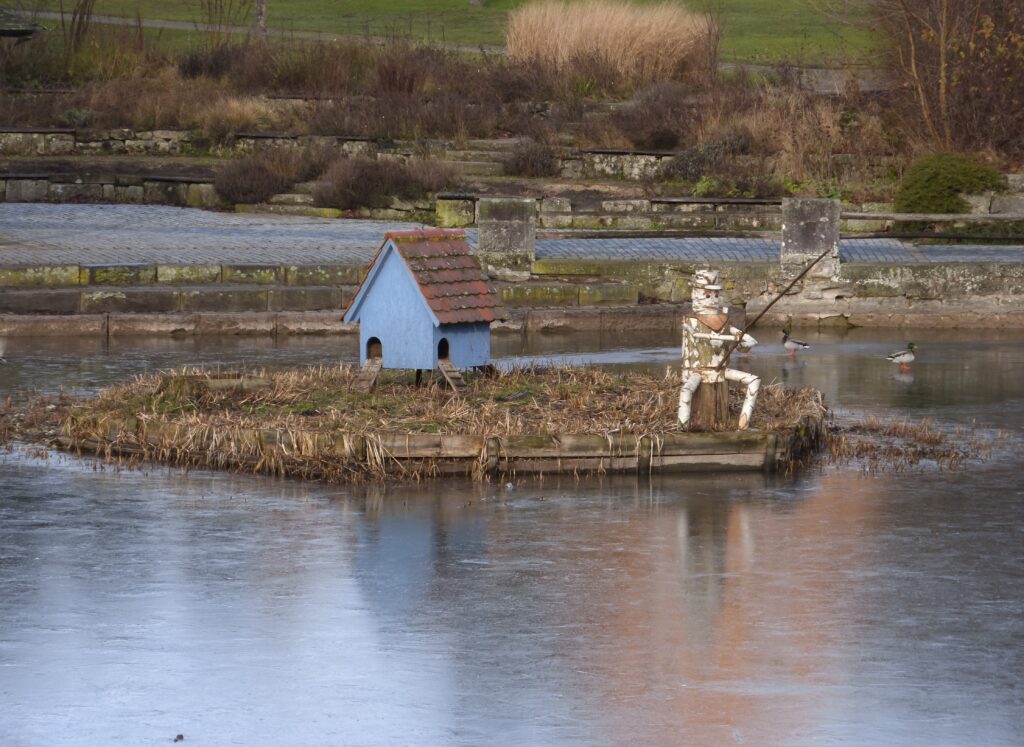
I liked this little guy fishing in the pond with the real-life ducks behind him in the water. Actually they were ON the water because it was frozen over.
Continuing around the pond we saw this tower called the Faulturm.
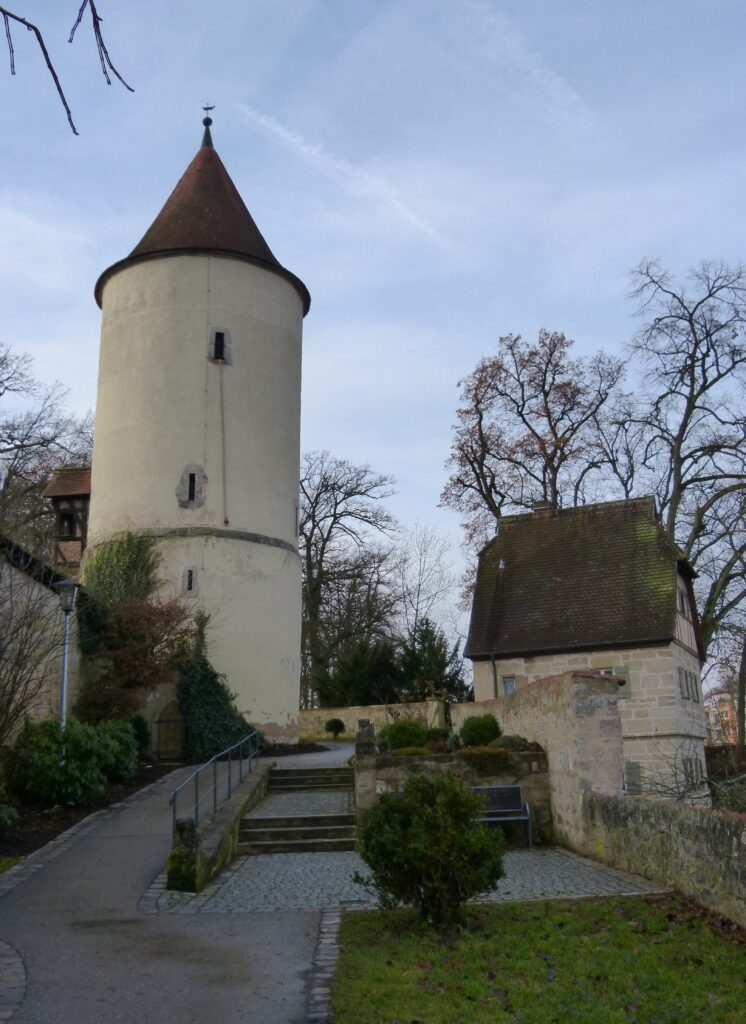
Is used to be the debtors’ prison, and the little building you see next to it was the caretaker’s lodge.
You may be able to see what looks like a rope hanging from the top window of the tower. Here’s a closeup.
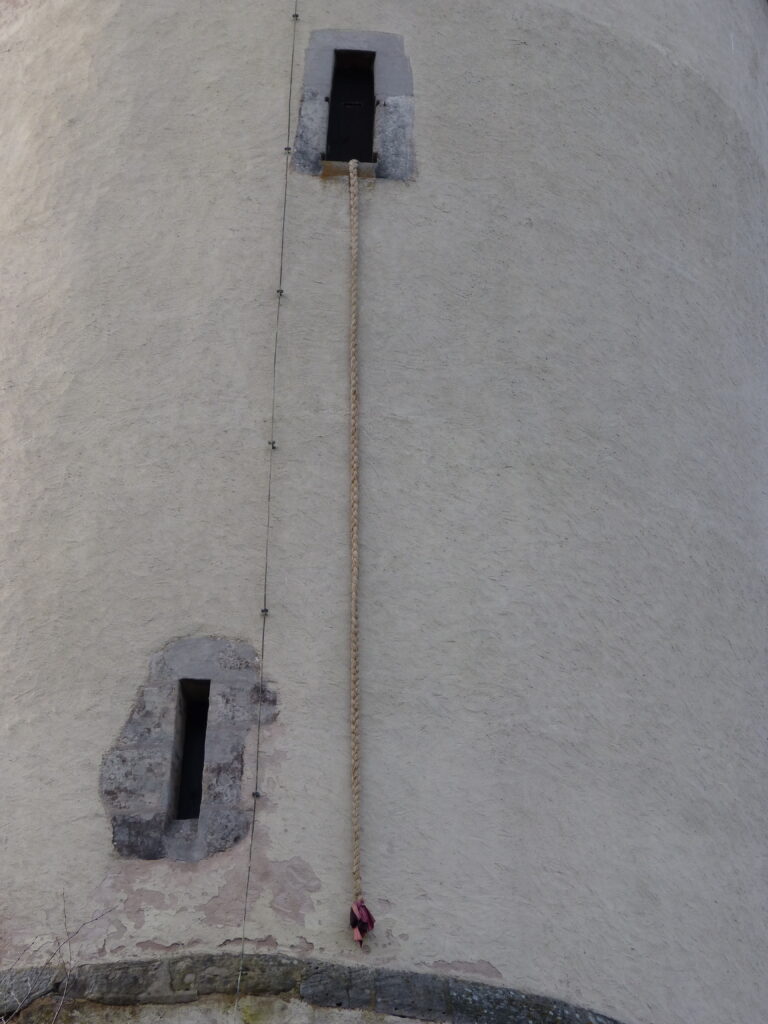
It’s a braided rope and Sean thought maybe it was supposed to be Rapunzel’s hair.
This next building was another corn storehouse.
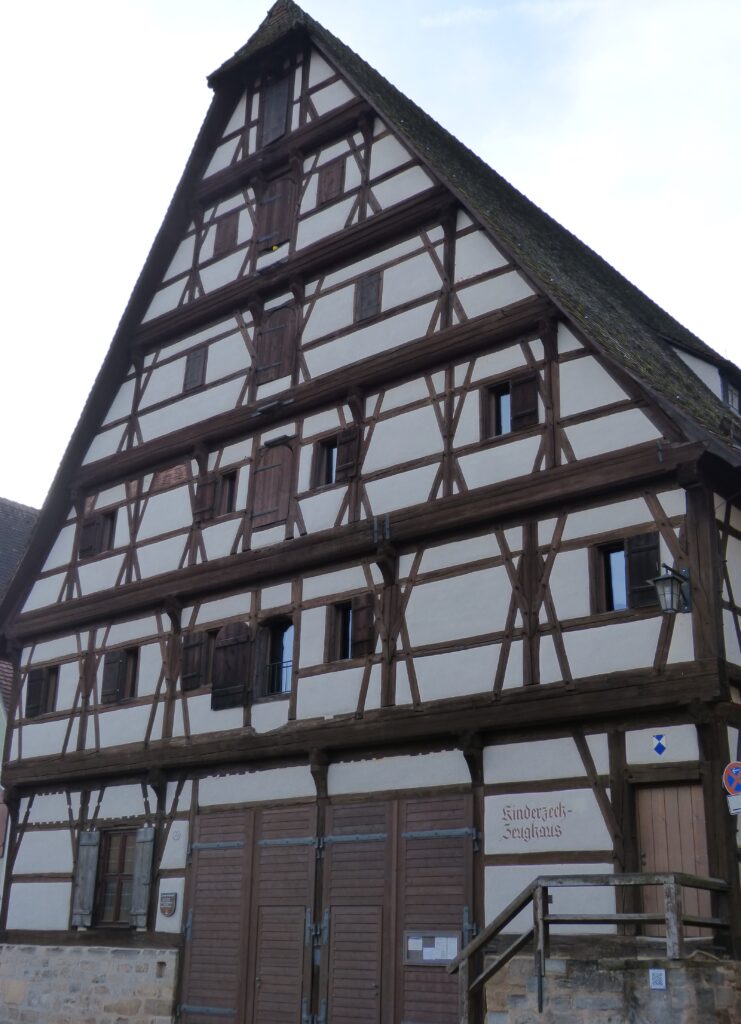
It was built in the year 1500, as shown in this next photo.
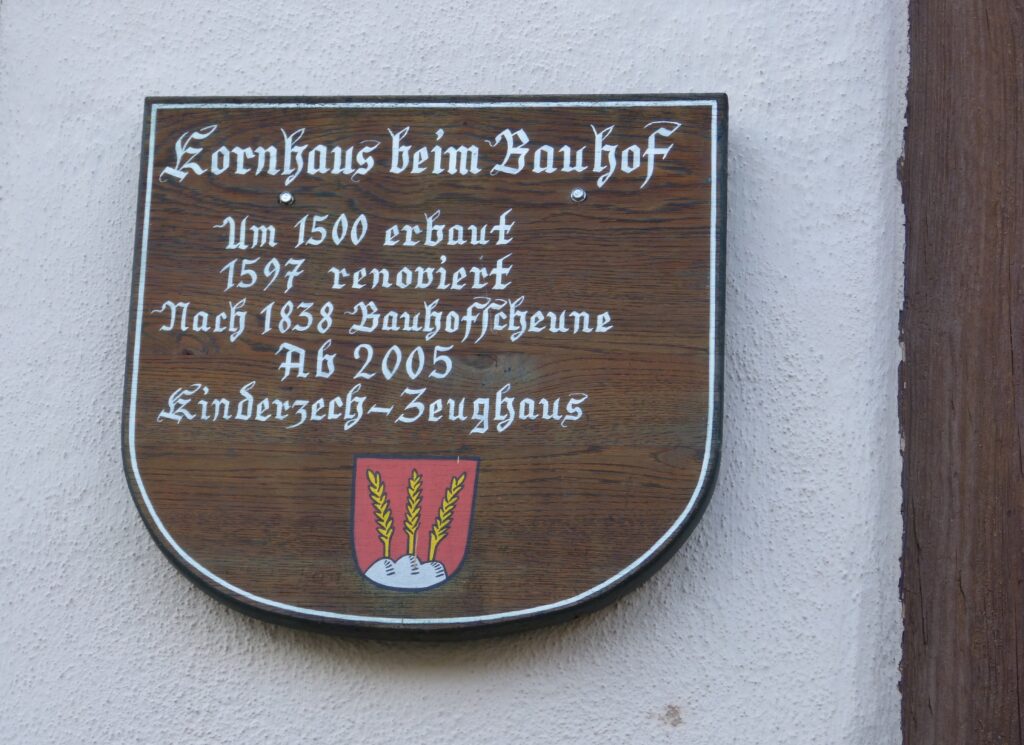
The German word erbaut means built. The depiction on this sign of the three ears of corn on top of three hills is Dinkelsbühl’s coat of arms.
We next ran across this crucifixion scene.
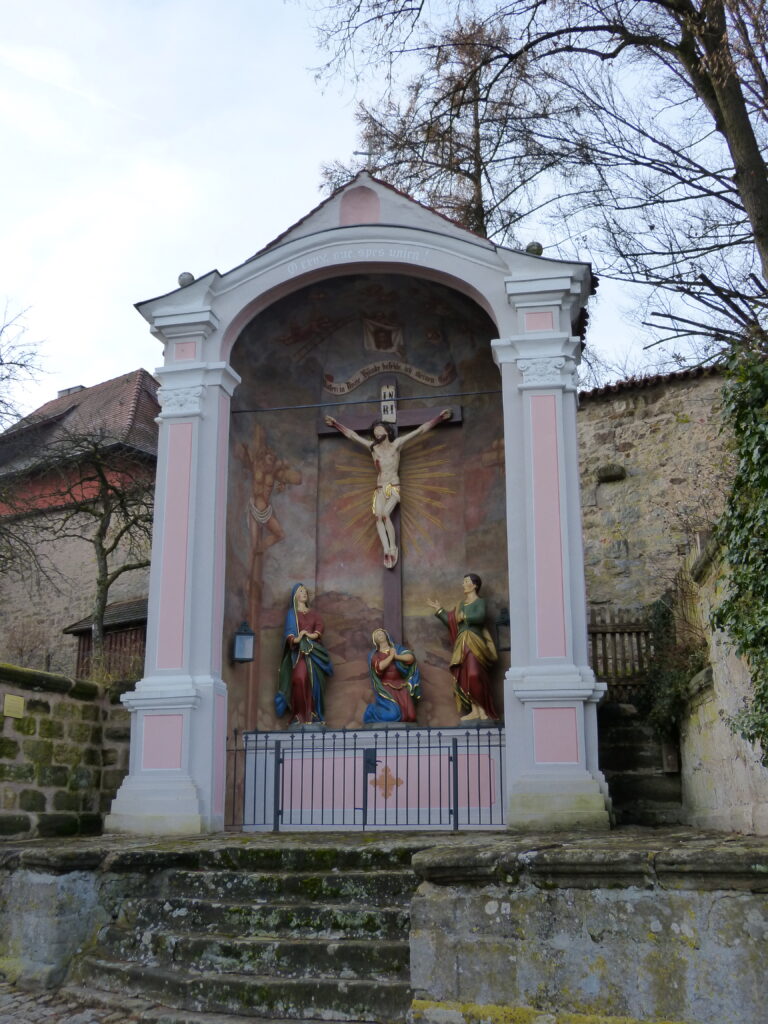
It wasn’t listed on the map as part of the walking tour, but you couldn’t miss it. The sign next to it said Vergelt’s Gott, which I translated after we got home and found out that it means God Bless You. The sign also said that donations would go towards the restoration of a chapel.
This next tower is the Grüner Turm or Green Tower.
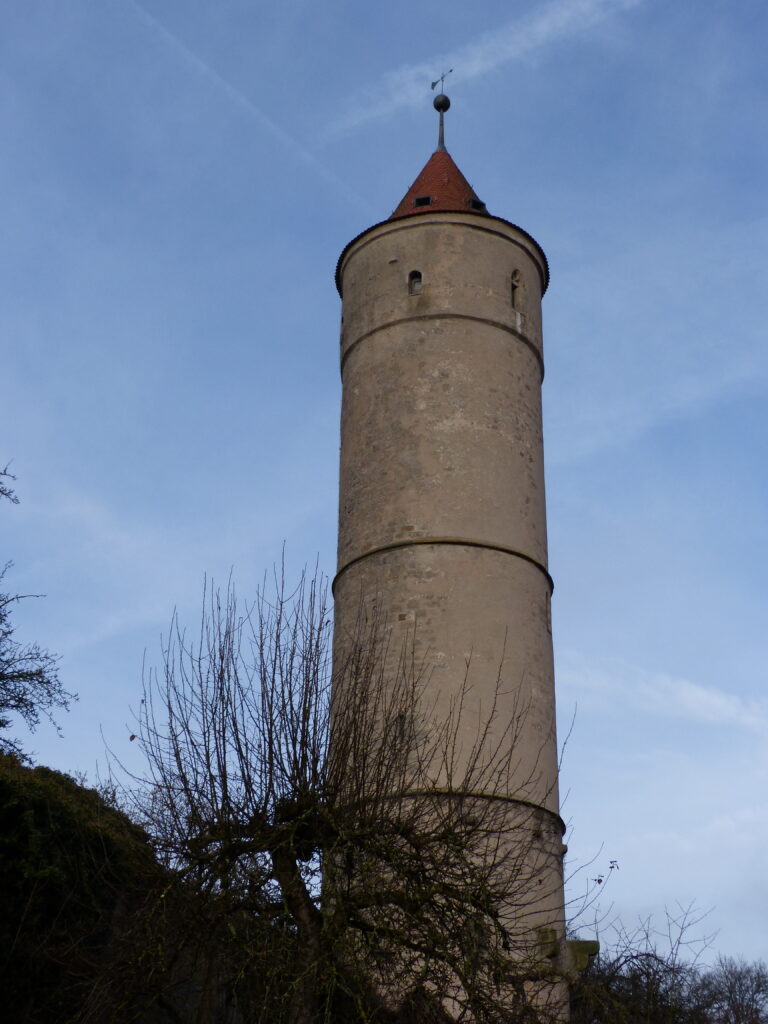
It was a former watchtower that was party of the town’s defensive wall.
And here we have yet another corn storehouse.

Those medieval people apparently really liked their corn. The building dates from 1508. It is supposedly now used as a youth hostel, but it looked empty and closed when we went by. I just Googled it and found the following at their website: “We’re sorry to inform you that the caretakers’ couple resigned very surprisingly for February, 28th 2013. Thus at the moment we can’t tell whether a short term solution will be found to keep up the hostel until fall next year.”
The site goes on to say the renovations will be ongoing until the year 2015 and the hostel will be closed during that time. I’m not a fan of hostels (I’m too old and too spoiled) but for those who are it looks like it would be an interesting place to stay.
Update: The hostel is once again open and taking reservations. https://www.dinkelsbuehl.de/englisch/youth-hostel
This is the Segringer Tor.
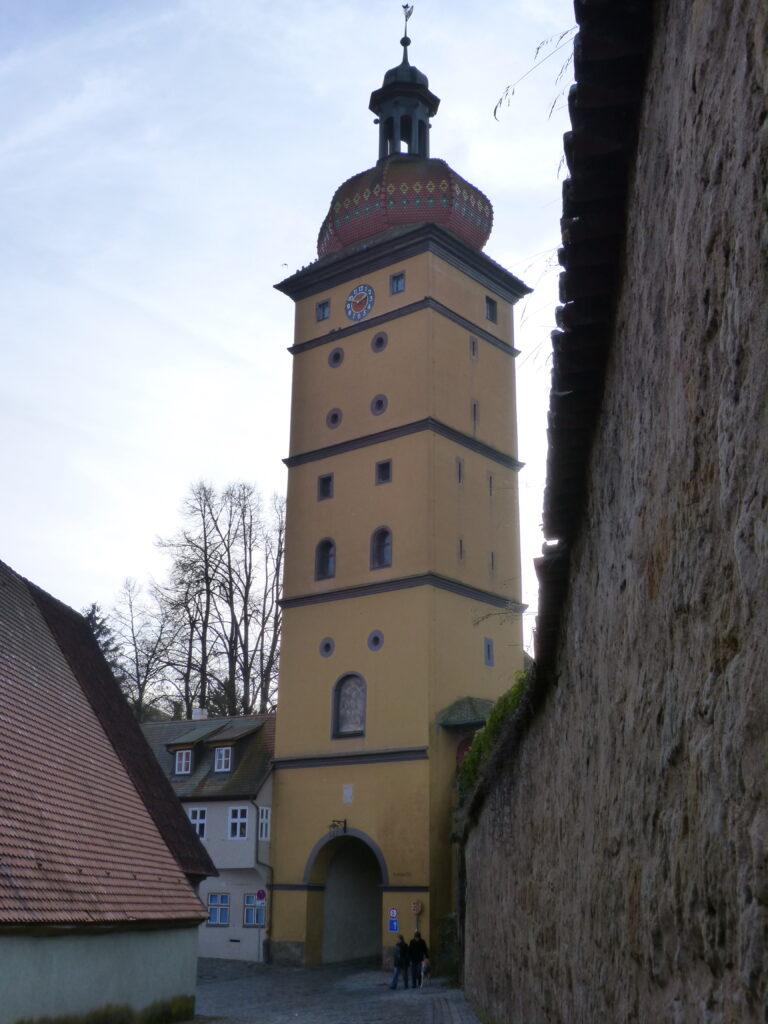
It’s the second of the four city gates that we saw. It was destroyed by the Swedes in 1648 and rebuilt in 1655. Note the arch underneath the tower where vehicles can pass through, because that will be important in a minute.
Here is the Dreikönigskappele or Three Kings Chapel.
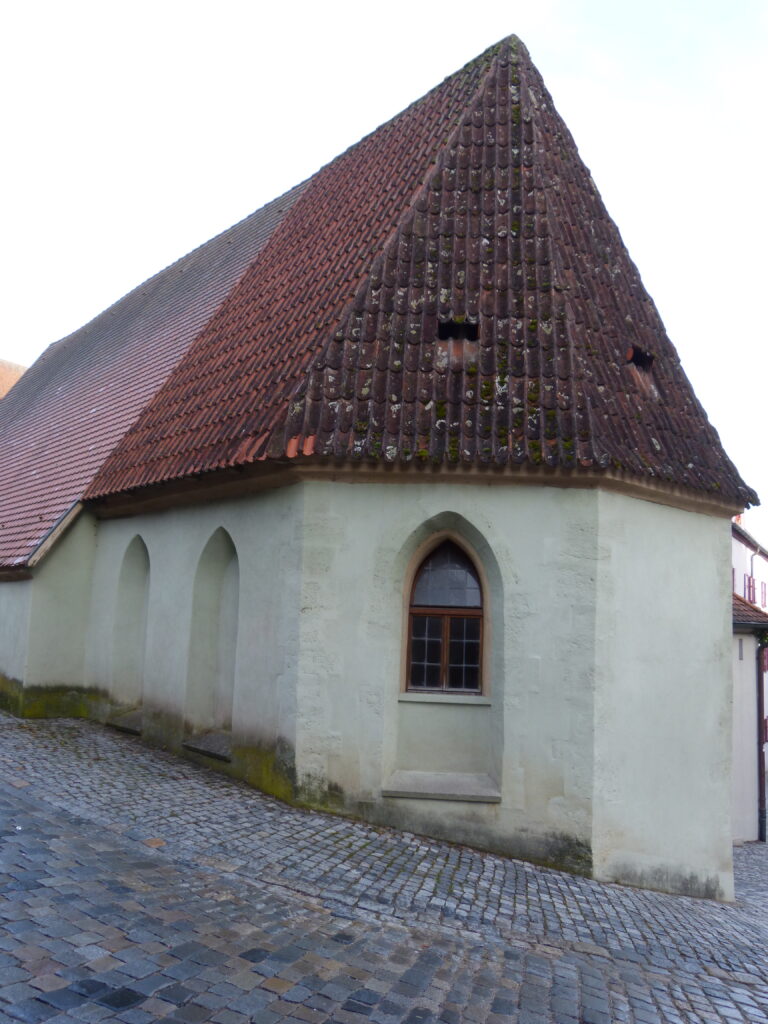
The first mention of the chapel was in records from the year 1378. It now serves as a war memorial chapel but it was not open when we ran across it.
Now, remember the arch that I just asked you to notice in the Segringer Tor? Check out this sign at the arch.
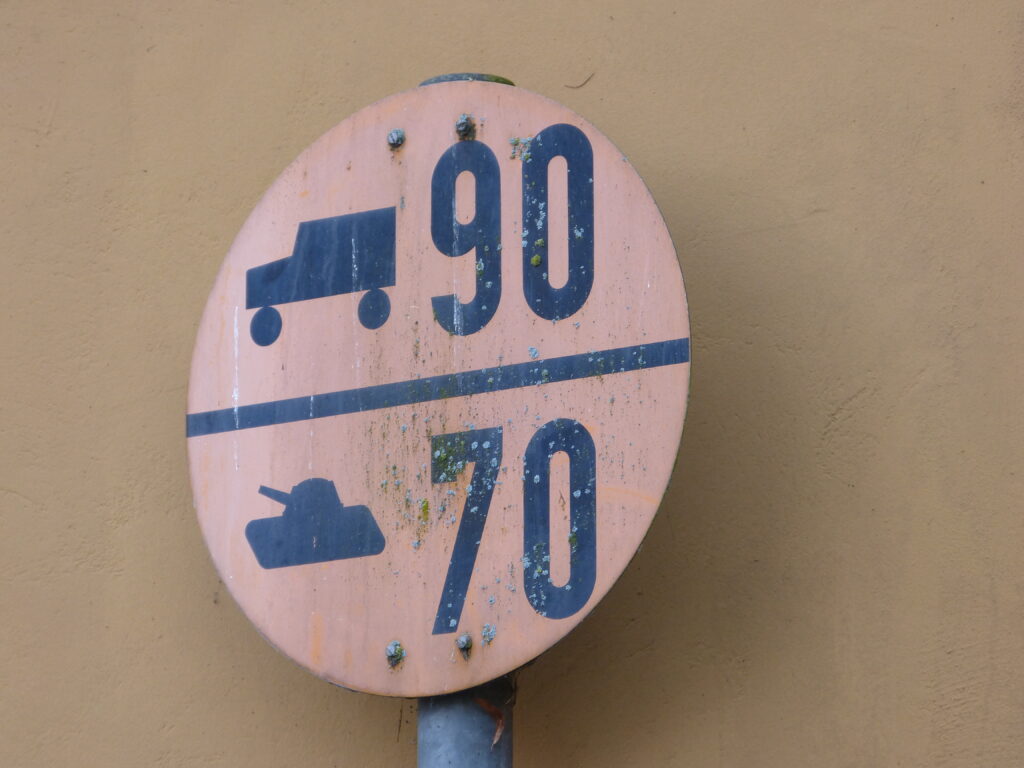
That’s right, cars can go through the arch at 90 kilometers an hour but tanks have to slow it down to 70 kilometers an hour. These signs are all over Germany but I have yet to see a tank driving on a road. I’m good with that.
The little area in this photo shows part of where the moat around the town’s walls used to be.
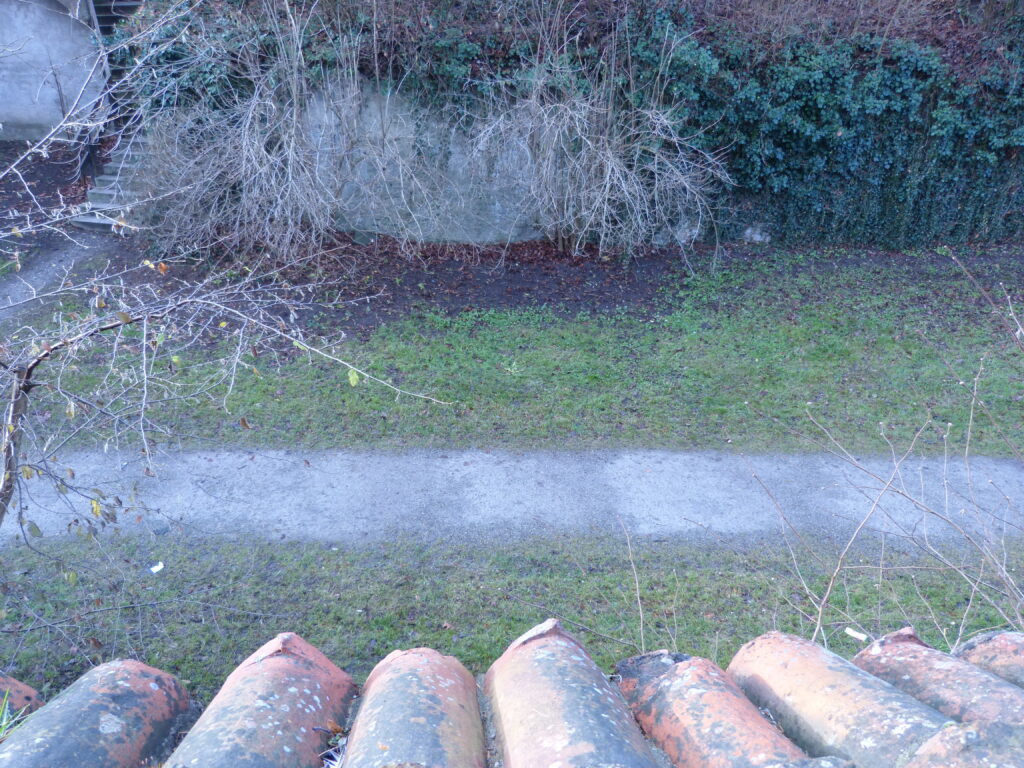
Here’s a view looking back at town and the St. George church.
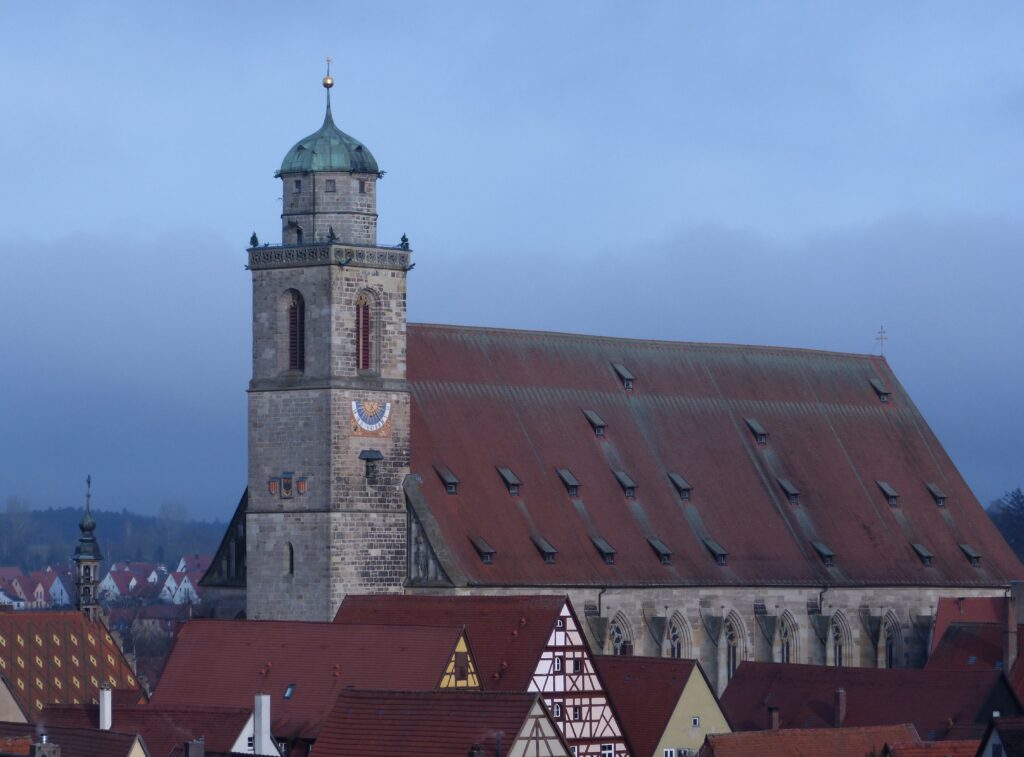
This next photo shows the Deutschordensschloss.
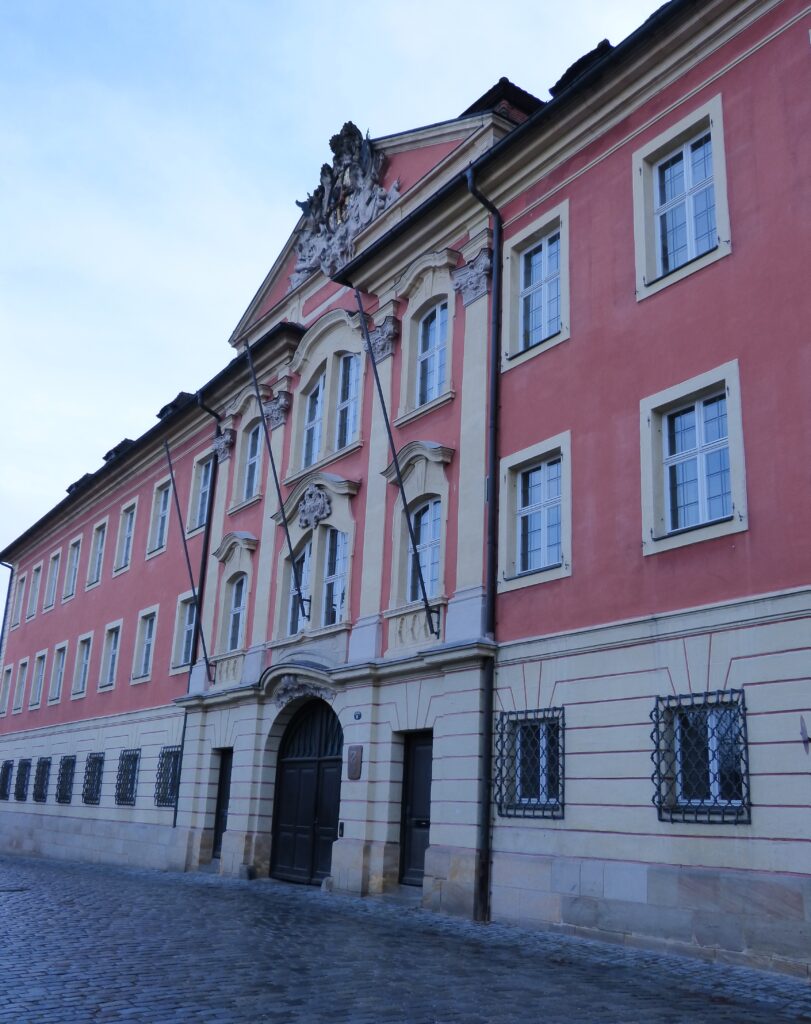
The English map calls it the House of the Teutonic Order. It says there’s a rococo chapel worth seeing, but we unfortunately couldn’t see it as the building was not open.
We kind of ended the walking tour there and did not see everything on the map. That’s because it was mainly defensive tower/gate after defensive tower/gate and hey, at some point they all start to blend in.
We did check out this building from a distance back at the parking lot, though.
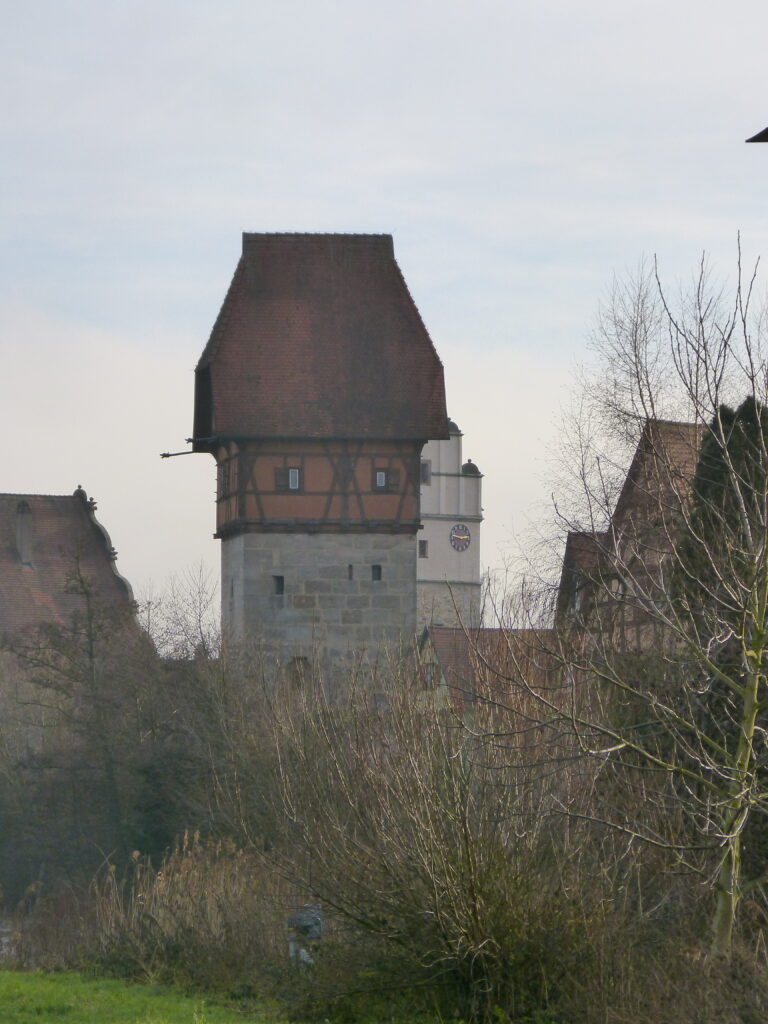
We sort of felt obligated to look at it because the map said it was a famous landmark of the town. It’s called the Bäuerlin Tower after a guy named Hans Bäuerlin who was a tower guard.
Back at the hotel in Rothenburg, Sean decide he needed some liquid refreshment.
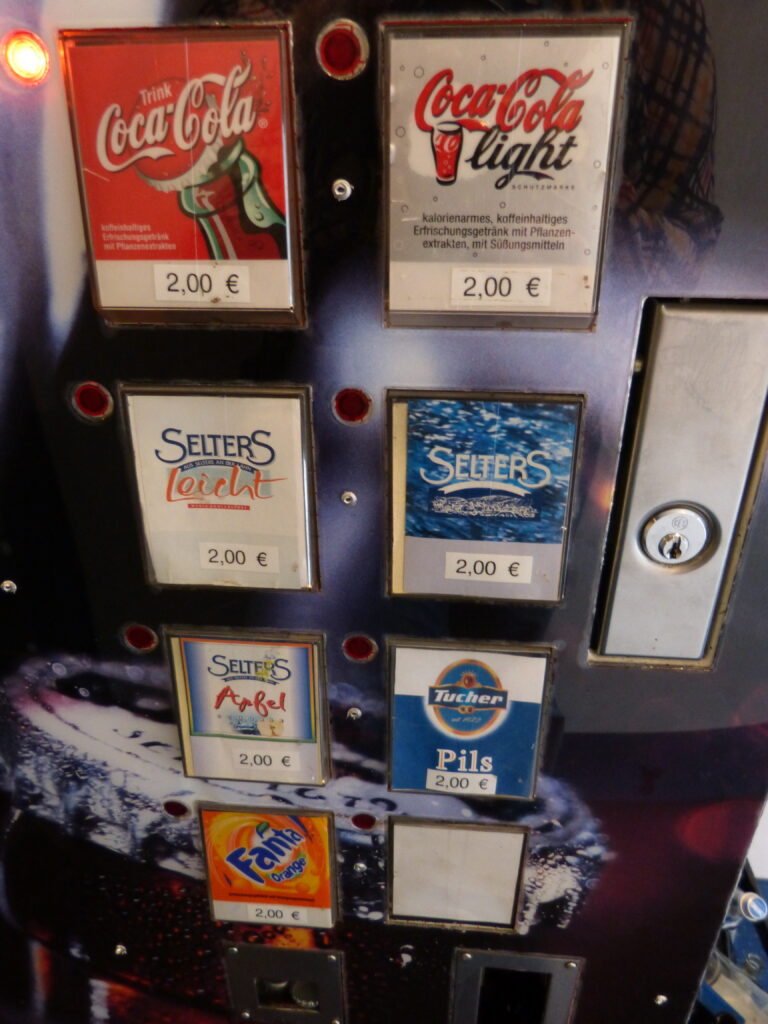
You’ll notice that everything from this vending machine, which was just across the hall from our hotel room, is 2 Euro. Yup, if you want a Coke or a Fanta or a Selters (mineral water) they are all 2 Euro. And oh, what’s that below the Selters on the right-hand side? Why yes, it IS beer! In a real glass bottle, no less. And there’s even a bottle opener conveniently built into the vending machine. I’ll leave it to you to guess which liquid refreshment Sean chose. This vending machine is one of the many things I love about Germany.
That night we just had a light dinner in Rothenburg and started the drive home the next morning after another early-morning walk around town and some breakfast.
Before I move on to some other sights along the Romantic Road, I thought I’d share this with you.
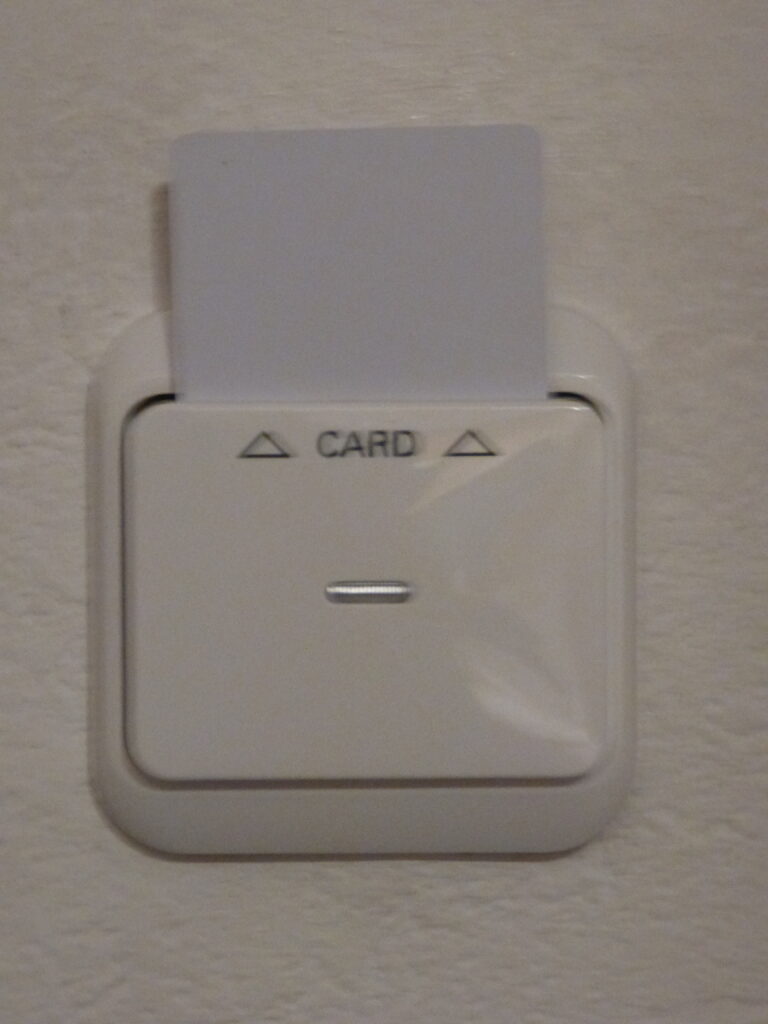
A lot of people checking into a European hotel for the first time – like us, years ago – do not realize how the electricity works in many hotels. In the name of energy-efficiency, you have to put your room key into a slot like this in order to get the lights and electrical outlets to work. The slot is always somewhere just inside the door. The downside to that is you can’t leave your personal electronics to charge when you’re out of the room unless you leave a room key in the slot to keep the electricity on. The upside is when there is no key in the slot, energy is not being wasted.
On the way home from Rothenburg, we stopped at a couple of other towns along the Romantic Road. Although we didn’t actually see much, we hope to revisit some of these places at a later date.
The first town we stopped at is called Creglingen.
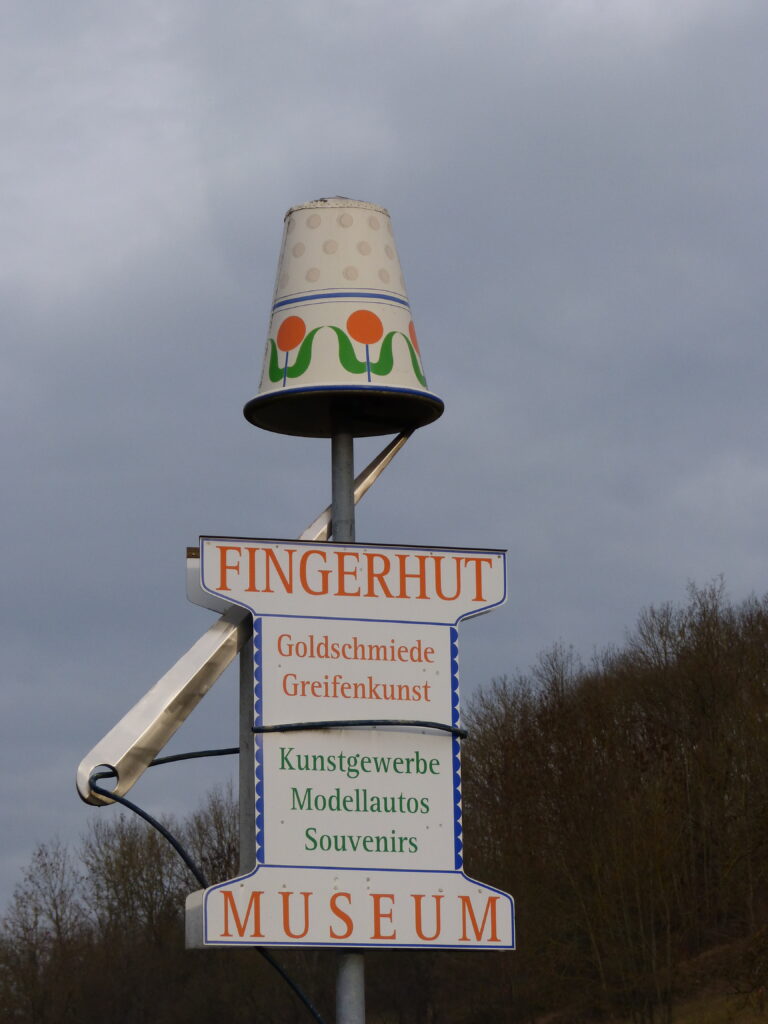
I liked the sign for their Thimble Museum. It’s pretty self-explanatory, huh? Fingerhut in German literally means finger hat, which is pretty much what a thimble is. The museum was closed when we were in town or I probably would have checked it out.
Across the street from the Fingerhut Museum is the Herrgottskirche church. That was also closed when we were there, but I’d like to go back because it has a Tilman Riemenschneider altar. If you read my blog on Rothenburg ob der Tauber, you might remember that we saw two Riemenschneider altars there and they are pretty elaborate. The one in Creglingen is supposed to be the best, though.
We next stopped in a town called Weikersheim. This little guy on top of a fountain welcomed us into town.
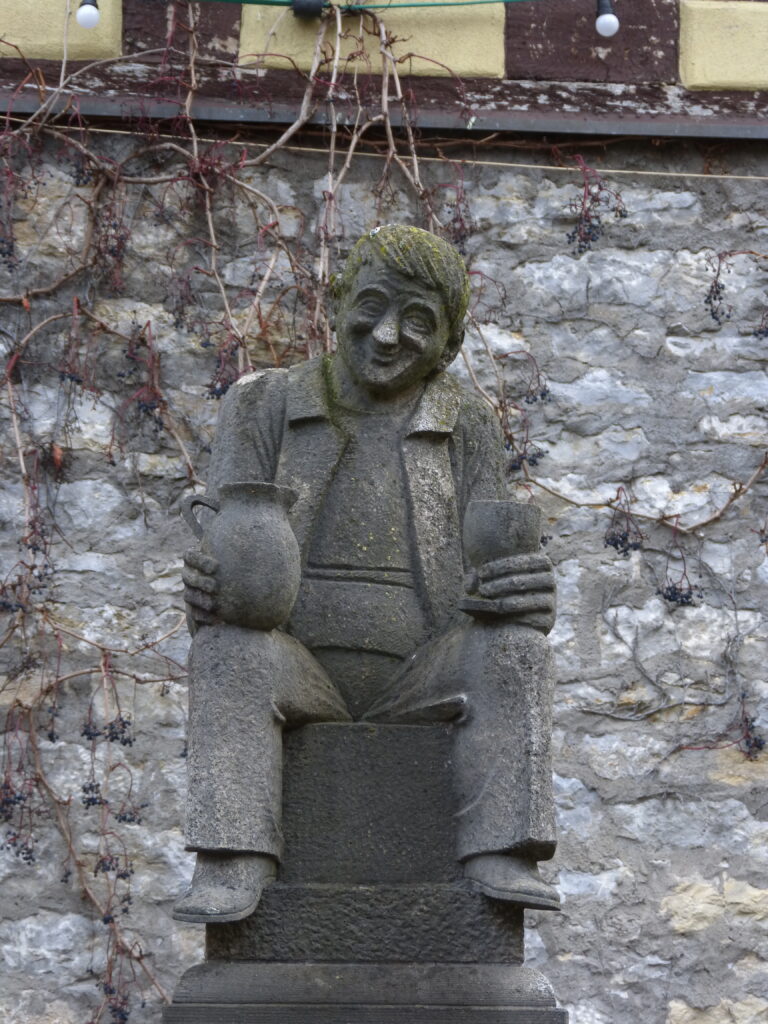
Sean hazarded a guess that maybe the figure represents the town drunk. If it does, at least he looks like a happy drunk.
The bird sitting in this window is a real, live bird.
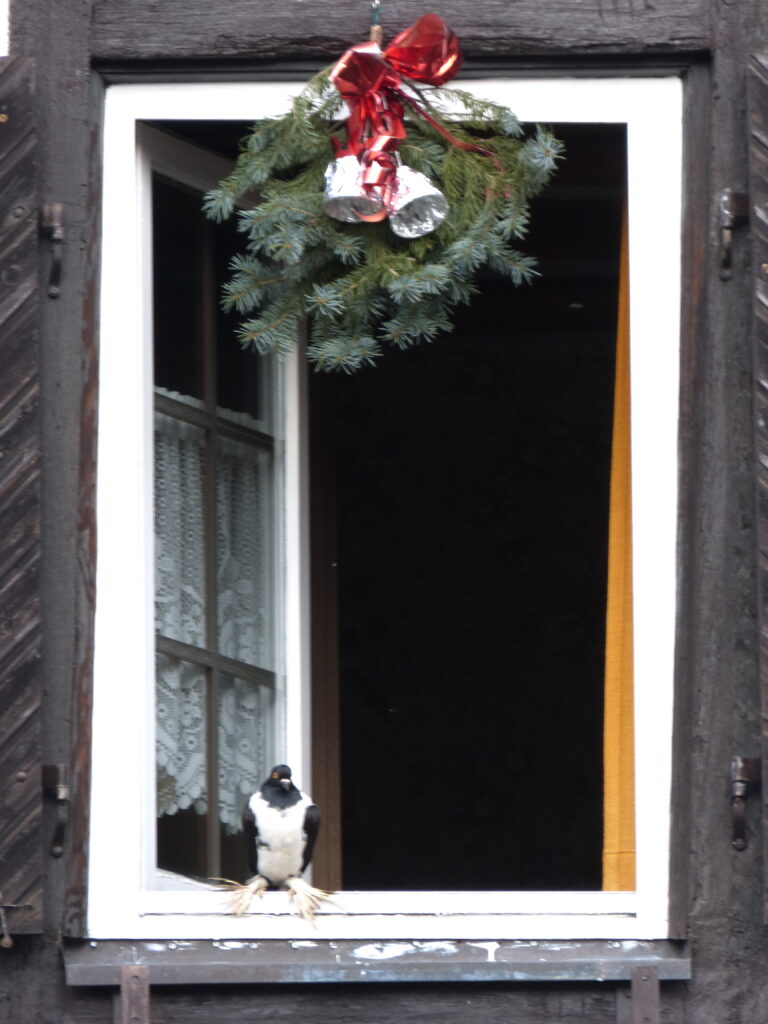
We watched it for while to verify whether it was real and it did indeed move around a bit. This building had almost all its windows open and lots of bird feeders hanging around, so they are obviously used to birds sitting in the windows.
This is the Schloss Weikersheim, the town palace.
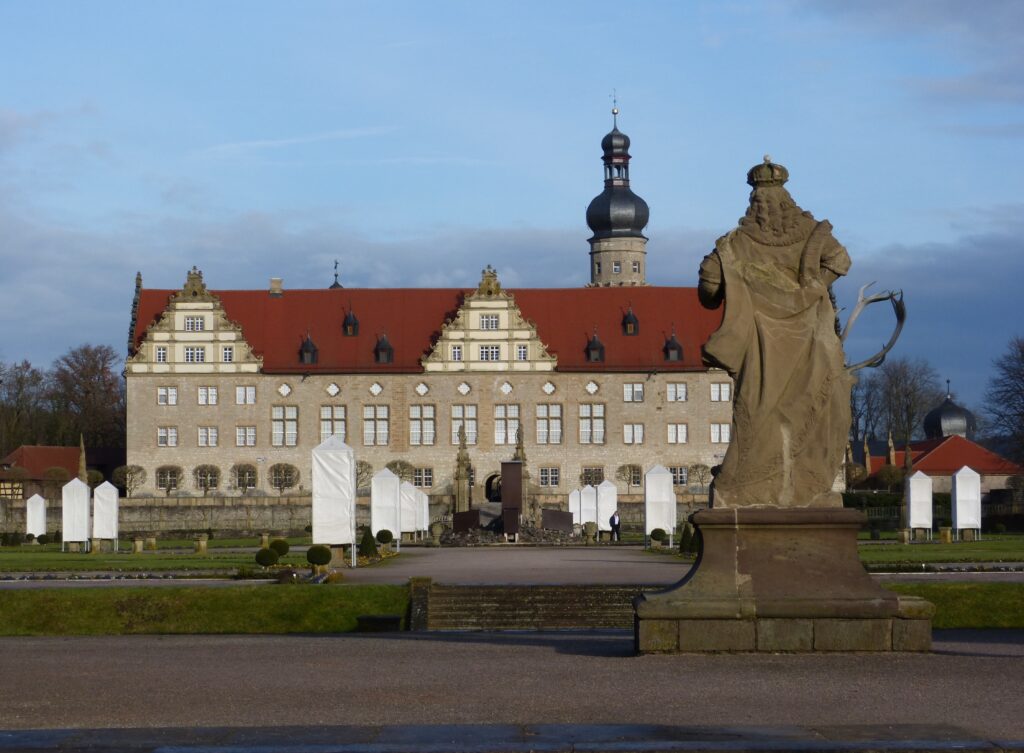
It too was closed during the time we were there. In fact it had just closed for a lunch break but we walked the Prinz-Constantin-Weg, which is about a 20-minute loop that takes you through a park and around the palace. It was a beautiful winter day and there were almost no tourists in this town so it was a nice walk. The gardens at the palace are supposed to be gorgeous, so I wouldn’t mind going back another time when everything is in bloom.
Our walk took us past the town square, which as you can see was empty.
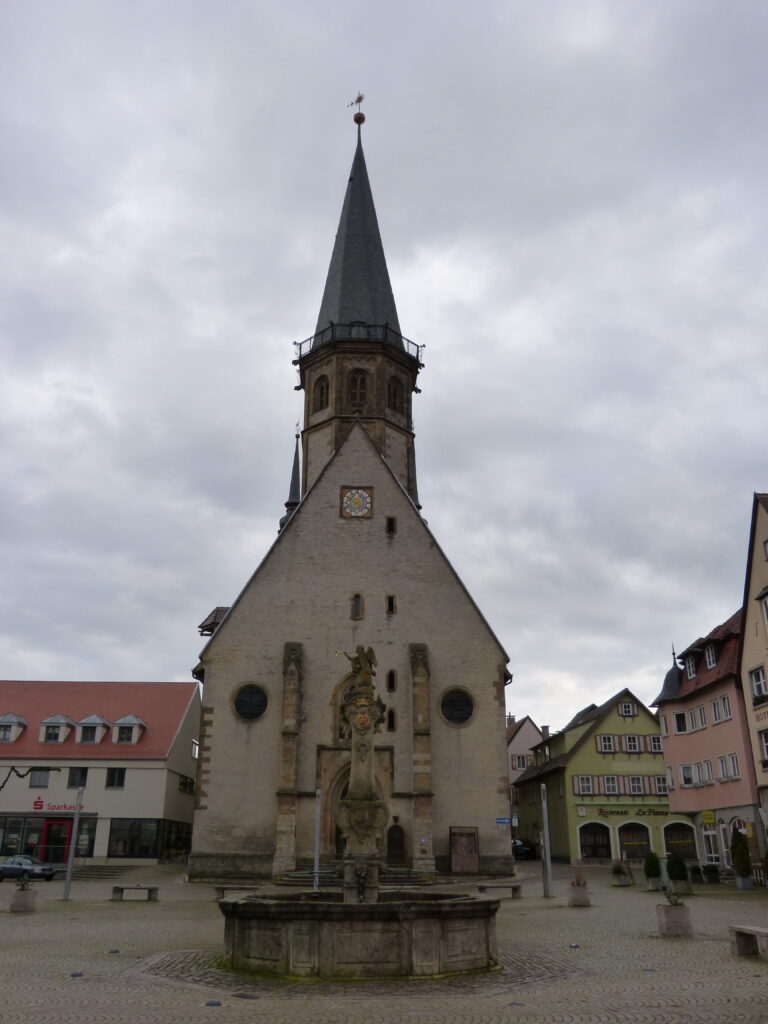
The tourist information office is located on this square but it was closed as well. The church you see there is called St. George, just like the church in Dinkelsbühl that you saw above. The name George in German is Georg and it seems to be a very popular name in this area. When we went to the Herrgottskirche church in Creglingen that you just read about and discovered that it was closed, we walked around the adjacent cemetery and it seemed like every other male buried there was named Georg.
This is the entry to the Schloss.
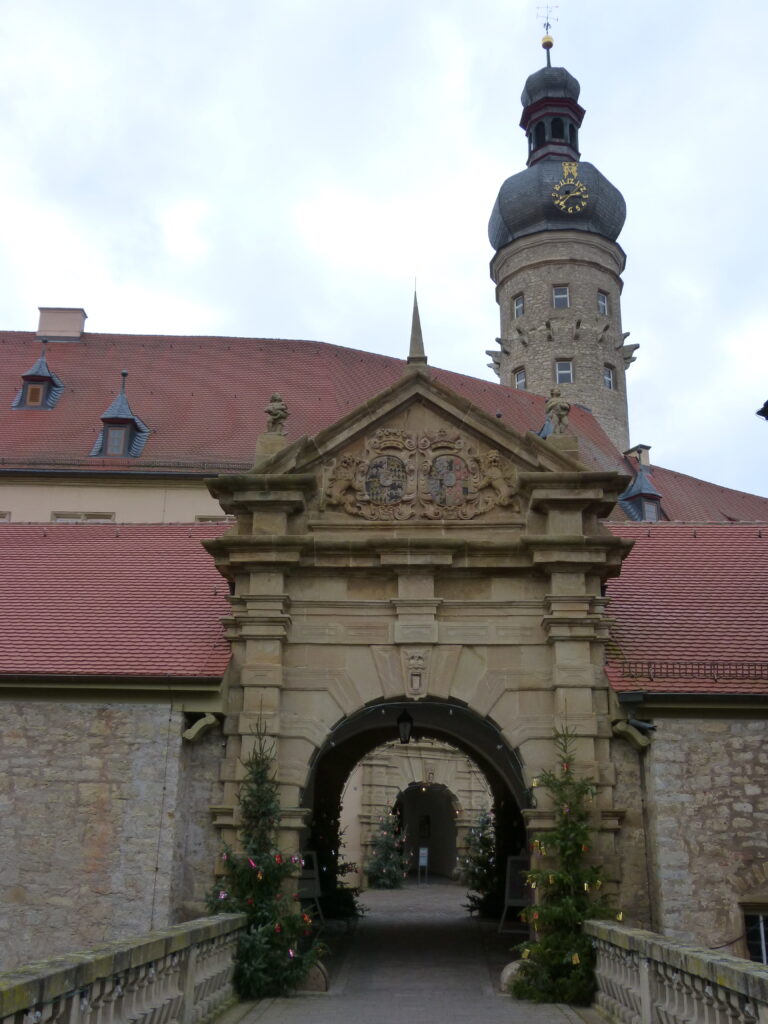
Although we couldn’t get into the palace itself, there is a small rose garden that is free. Of course the roses are not blooming now, but we did get to see this anatomically correct statue in the garden.
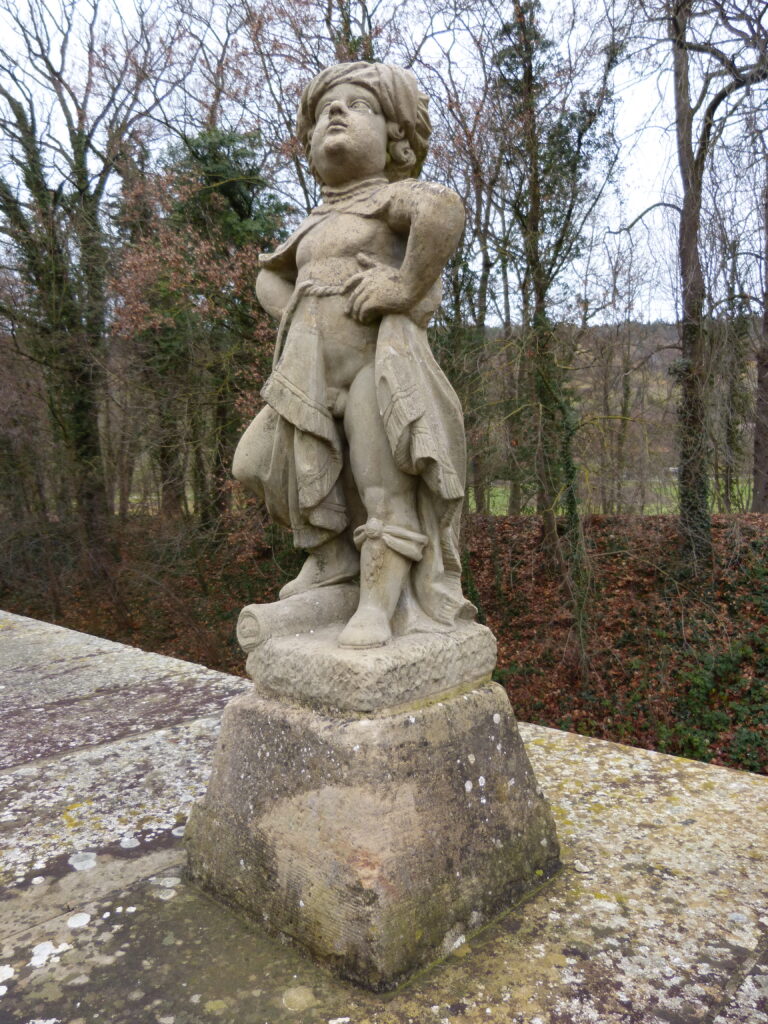
How many of you just enlarged the photo to see if the statue was in fact anatomically correct?
Here is one more view of part of the palace grounds.
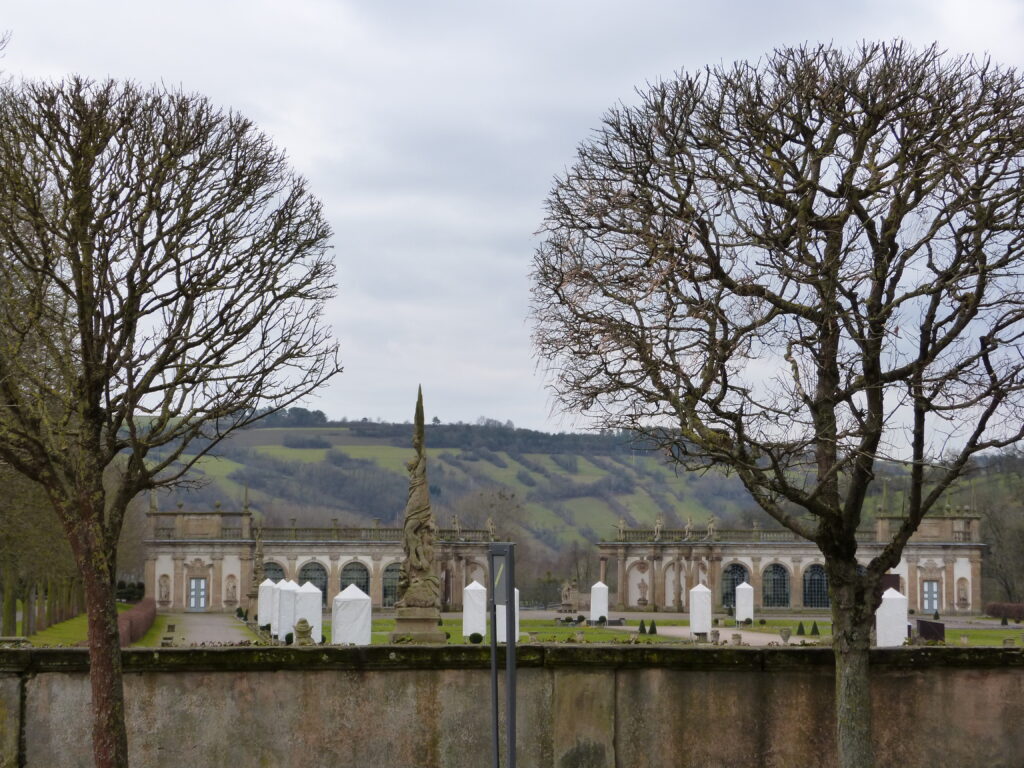
This shows the palace’s orangery, which is basically a greenhouse.
Although I wish we’d timed it better to be able to visit some of the sights in these towns, the drive along the Romantic Road was nice and I hope to be able to do it again in warmer weather.

